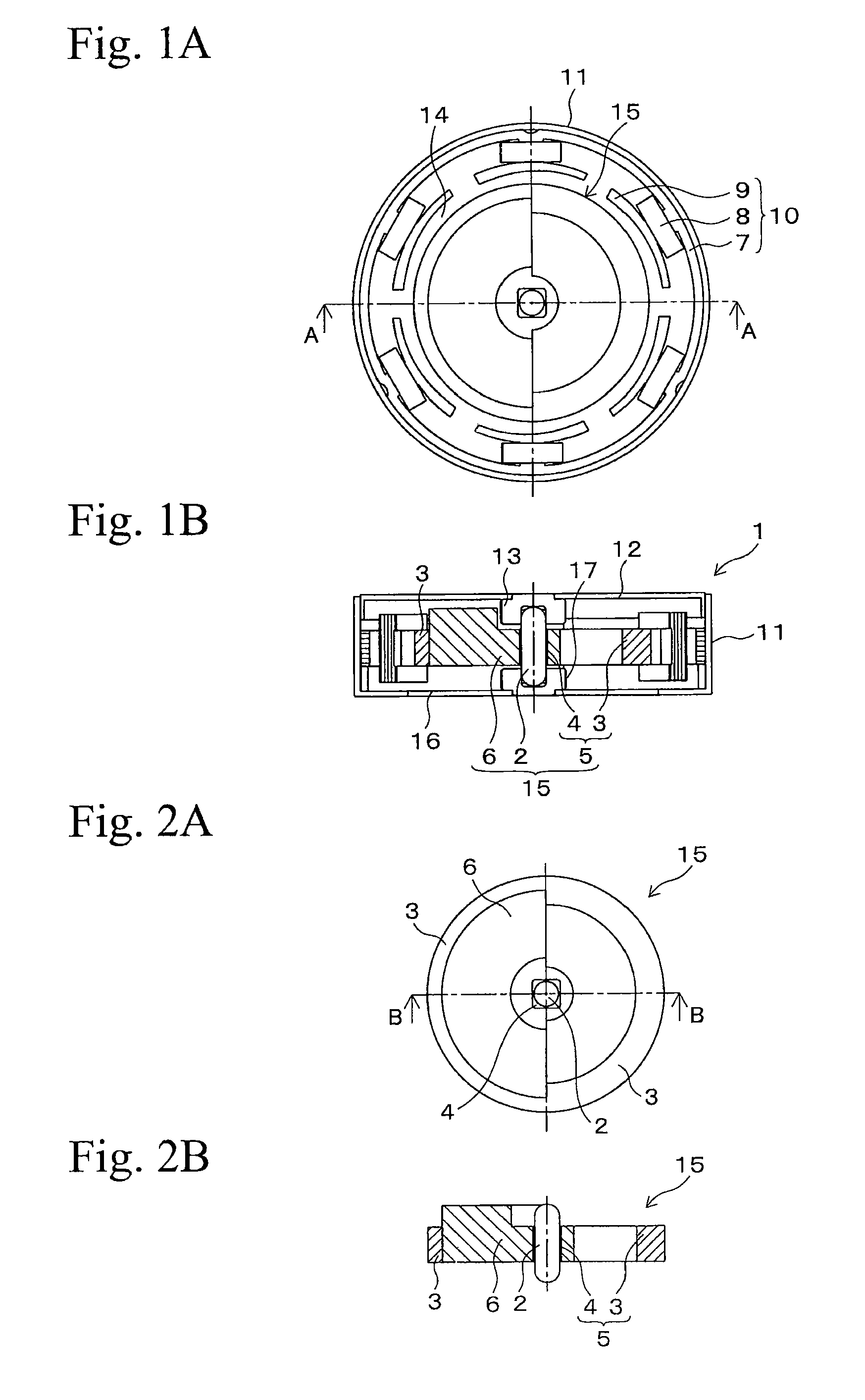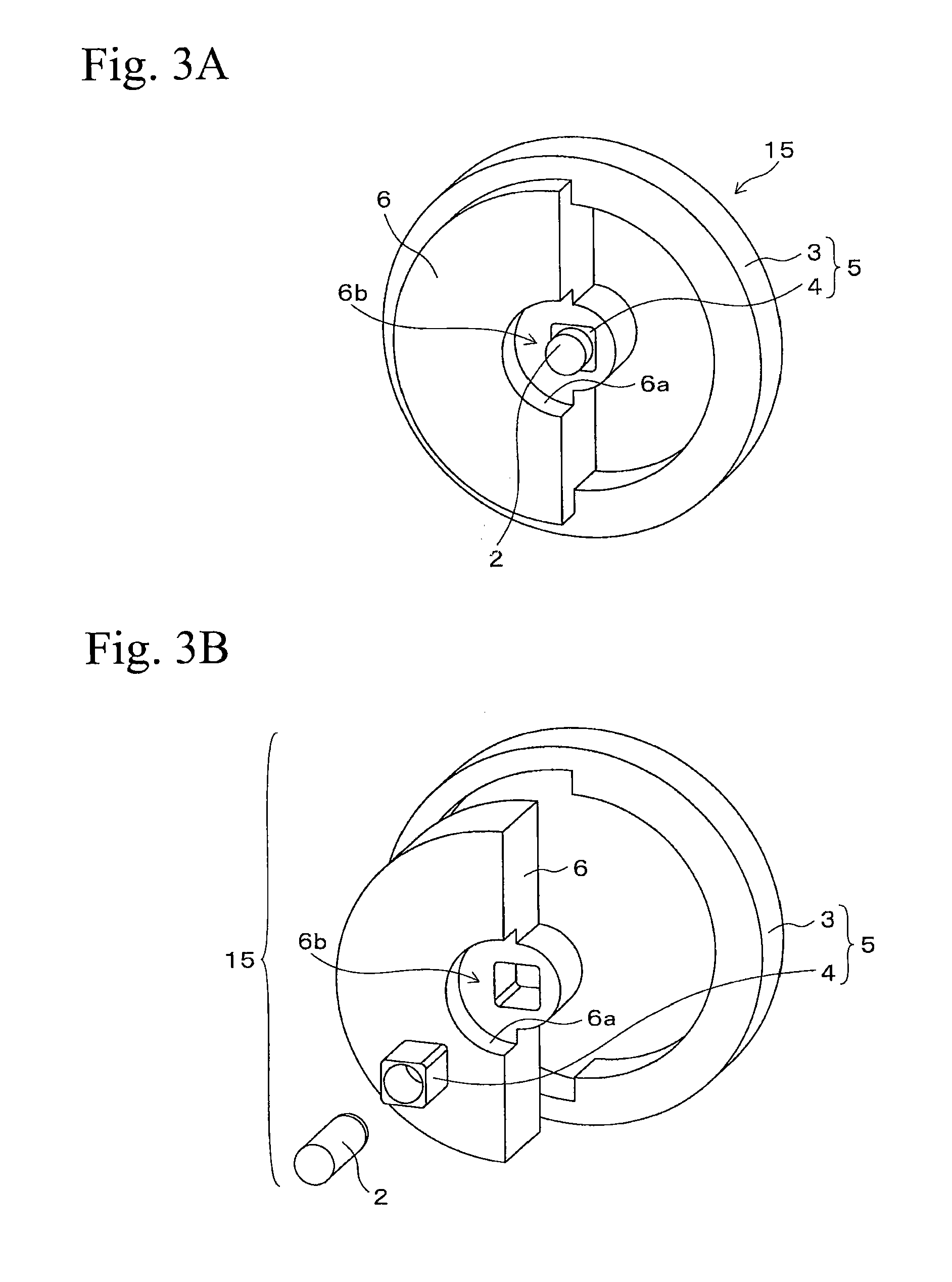Production method of vibrating motor and rotor for vibrating motor
a technology of vibrating motor and rotor, which is applied in the manufacture of stator/rotor bodies, mechanical energy handling, and applying solid insulation, etc., can solve the problems of limited coaxial accuracy of rotors, the number of parts is not easily reduced, and the production cost of rotors is not reduced. , the effect of reducing the number of parts
- Summary
- Abstract
- Description
- Claims
- Application Information
AI Technical Summary
Benefits of technology
Problems solved by technology
Method used
Image
Examples
second embodiment
[0062]FIG. 4 A is a plane view and FIG. 4B is a cross sectional view of a vibrating motor 20 in accordance with a second embodiment, each of FIGS. 4A and 4B is viewed from the same direction as FIGS. 1A and 1B. The shape of an eccentric weight 21 of a rotor 22 is different from that of the vibrating motor 1 in FIGS. 1A and 1B. In the vibrating motor 20, an extensional portion 21a is provided, in which the outer surface of the eccentric weight 21 is extended up to the outer surface of the permanent magnet 3 for more effective vibration. The shape of the extensional portion 21a partially overlaps with the permanent magnet 3 when viewed from an axial direction. According to the structure of the embodiment, a mass of the extensional portion 21a is added to an outer surface of the rotor 22, whereby mass unbalance to the shaft 2 is increased and more effective vibration is obtained.
[0063]FIG. 5A is a plane view of the rotor 22 and FIG. 5B is a cross sectional view of the rotor 22 taken al...
third embodiment
[0065] FIG. 6A is a plane view and FIG. 6B is a cross sectional view of a vibrating motor 30, each of FIGS. 6A and 6B is viewed from the same direction as FIGS. 1A and 1B. FIG. 7A is a plane view of a rotor 32 in FIG. 6A, and FIG. 7B is a cross sectional view of the rotor 32 taken along line B-B in FIG. 7A. The vibrating motor 30 is shown in FIGS. 6A and 6B. In the vibrating motor 30, an extensional portion 31a is provided, and in order to obtain effective vibration, one side of an outer surface of the eccentric weight 31 is radially extended up to the position overlapping with the pole teeth 9 when viewed from an axial direction. The extensional portion 31a does not contact the members in the stator 10. Portions other than the eccentric weight 31 in the vibrating motor 30 are the same as the portions of the vibrating motor 1 shown in FIG. 1A. According to the structure, the mass of the extensional portion 31a is added at an outer side of the rotor 32, whereby mass unbalance to the ...
fifth embodiment
[0067] FIG. 10A is a plane view and FIG. 10B is a cross sectional view of a vibrating motor 40, and each of FIGS. 10A and 10B is viewed from the same direction as FIGS. 1A and 1B. FIG. 11A is a plane view of a rotor 52 in FIG. 10A, and FIG. 11B is a cross sectional view of the rotor 42 taken along line B-B in FIG. 11A. A vibrating motor 50 is shown in FIGS. 10A and 10B. In the vibrating motor 50, both axial sides of the outer surface of an eccentric weight 51 are radially extended up to the same position in the vibrating motor 40 shown in FIGS. 8A and 8B. That is, in the vibrating motor 50, an eccentric weight 51 is provided such that both upper and lower axial sides thereof are radially extended as shown in FIG. 10B. An external portion 51a and an external portion 51b are provided at an upper side of the extended portion of the eccentric weight 51, an external portion 51c and an external portion 51d are provided at a lower side of the extended portion. The external portions 51a and...
PUM
| Property | Measurement | Unit |
|---|---|---|
| specific gravity | aaaaa | aaaaa |
| circumference | aaaaa | aaaaa |
| axial length | aaaaa | aaaaa |
Abstract
Description
Claims
Application Information
 Login to View More
Login to View More - R&D
- Intellectual Property
- Life Sciences
- Materials
- Tech Scout
- Unparalleled Data Quality
- Higher Quality Content
- 60% Fewer Hallucinations
Browse by: Latest US Patents, China's latest patents, Technical Efficacy Thesaurus, Application Domain, Technology Topic, Popular Technical Reports.
© 2025 PatSnap. All rights reserved.Legal|Privacy policy|Modern Slavery Act Transparency Statement|Sitemap|About US| Contact US: help@patsnap.com



